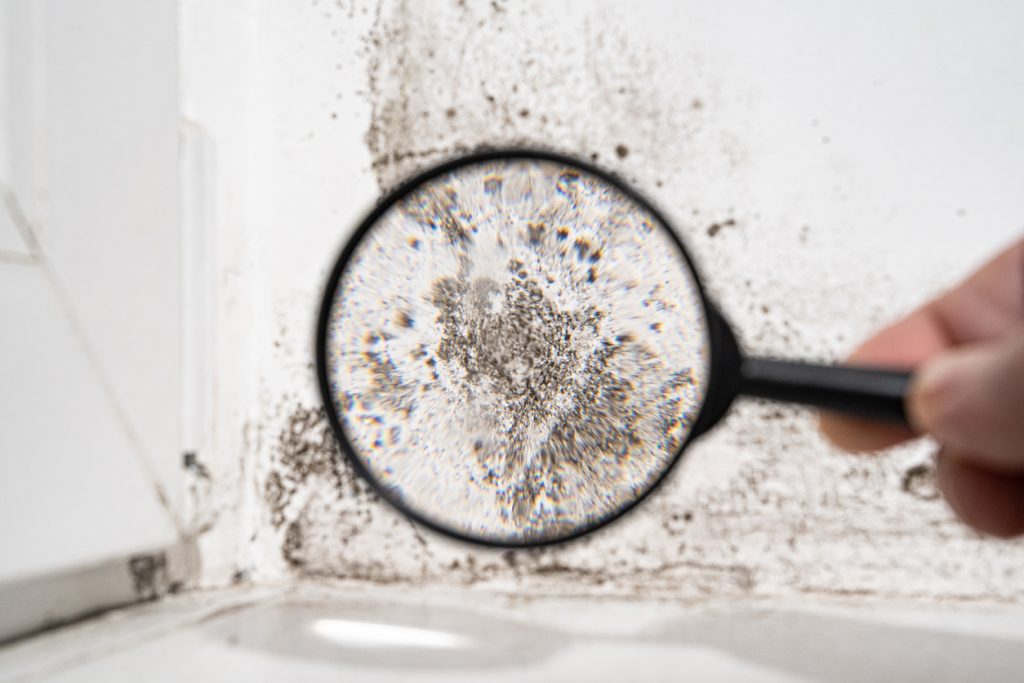Written by National Practice Leader, Building Science & Sustainability, Gord Rajewski and
National Practice Leader, Indoor Environmental Quality, David Muise
Originally published in Western Built Fall 2022 Magazine
The term ‘mould’ refers to a large group of microorganisms that grow on organic material and reproduce through the formation and spread of spores. These spores germinate within a few days of finding the right combination of surface and moisture, and can form new spores that produce the next generation of growth within 5 to 10 days.
Mould growth in buildings can occur when mould spores, which are always present in buildings, are exposed to wet conditions for a sufficient length of time and on an appropriate surface to support growth. Water sources can include plumbing leaks, spills, foundation seepage, roof or wall leaks, or condensation on cool surfaces, such as inside ductwork and on windowsills, etc. In the presence of wet or highly humid conditions, mould spores can germinate within 48 to 72 hours (about three days).
Health risks and effects
Exposure to airborne mould can have varying effects on building occupants depending on their individual sensitivities. Some common symptoms associated with exposure may include runny nose and congestion, eye irritation, coughing, and headache, to name a few.

view through a magnifying glass. white wall with black mold.
There are no set exposure limits for indoor airborne spore concentrations. Health impacts are more broadly related to the presence or absence of dampness and mould growth and not a specific spore concentration or type of mould. Furthermore, a combination of level of exposure, individual sensitivity, and extent and location of mould growth are all factors that may impact risk. Virtually all guidelines reviewed indicate that all mould can be harmful, so if discovered indoors, it should be eliminated.
Controlling mould growth in buildings
To remove all mould spores from a building, or to have a building that has no finishes that promote mould growth, is simply not possible. The only way to truly prevent mould growth in a building is with the careful management of humidity, condensation, and water intrusion via building envelope leaks, floods, or plumbing failures. For this reason, the risk of recurring mould growth must be addressed not only by repairs to address sources of water damage but through a comprehensive mould and water damage management program. Key elements of a mould and water damage management plan are:
- The training of facilities staff in the causes and how to identify indoor mould growth.
- Development of a surveillance program to ensure that all instances of water / moisture infiltration are discovered and mitigated in a timely manner. This could include:
- Regular building inspections to examine the condition of interior finishes that could be susceptible to water/moisture infiltration issues.
- Regular inspection of the interior accessible HVAC components.
- Regular review of exterior envelope conditions to look for deterioration that could lead to future water infiltration and subsequent mould growth.
Building science and mould control
In general, the buildings envelope is a key line of defense for mitigating water and moisture infiltration into a building. General building envelope methodologies include the concept of providing both waterproofing and shedding of water away from the building’s elements. The key building envelope concepts can be categorized into four components: deflection, drainage, durability, and drying. A properly designed, installed, and maintained envelope should be able to effectively deflect moisture from precipitation events, drain roof components efficiently away from the building, provide long-lasting materials and assemblies, and be implemented using three primary processes for drying.
- Diffusion, which is the movement of moisture through materials at the molecular level.
- Evaporation, which is the conversion from liquid to a gas at the surface.
- Convection, which is the transport of moisture via air currents.
To manage the negative effects of deleterious moisture within building enclosures, proper building envelope design must provide control layers that include water shedding surfaces, the design of building form and features to enhance drainage, employment of water resistive barriers, continuous air barrier systems, thermal insulation, and vapour retarder / barriers. These concepts and designs must be effectively communicated (including effective details, drawings, specification, and construction review services) during the construction and / or restoration of buildings in order to ensure continuity of building envelope concepts.

Moisture control and durability of our building envelopes is of particular concern in our northern climates, which are subjected to large temperature gradients, extreme weather, and requirement for indoor heat. In addition to the moisture infiltration from exterior sources, such as precipitation, the controlling of indoor temperatures can also impact the production of moisture within a building.
To remove all mould spores from a building, or to have a building that has no finishes that promote mould growth, is simply not possible. The only way to truly prevent mould growth in a building is with the careful management of humidity, condensation, and water intrusion via building envelope leaks, floods, or plumbing failures.
Similar to the concept of an aluminum can cooler sleeve, when warm air (indoor heated air) reaches a cool object (exterior / perimeter components of a building) it condenses, which creates moisture. To mitigate moisture within a building, effective building envelope detailing and construction techniques must be utilized. Building envelope and building science specialists play a vital role in the indoor quality of a building.
When moisture becomes a problem – the steps towards resolution
Mould is considered a symptom of a problem, and the roots are most often linked to a failure in the design and execution of the building envelope assembly and associated air handling systems provided. The process towards resolution of moisture issues within a building enclosure involves three phases, broken down into nine key elements:
PHASE 1
Condition assessment: Building Envelope Condition Assessments are undertaken as a first step towards the remediation of moisture problems in affected building enclosures. These assessments can include review of architectural as-built drawings and details, interviews with occupants, on site visual review, air leakage testing, and sample material testing.
Evaluation: Once the sources of problematic moisture are identified and understood, a conceptual remedial repair plan with design options is created and evaluated. In this step, we also draw upon our experience and industry knowledge, and consult with representatives from manufacturers to source appropriate options. Additional evaluations may include the use of analytical software.
System selection: Once the design options have been successfully evaluated, pre-construction estimates are provided for client approval. Obtaining a definitive estimate at this early stage is critical for the success of the project.
PHASE 2
Design: Drawings and specifications are developed based on the client’s selected system. The client provides a review of the design and confirms it is in line with their intent.
Tender: A tender package is created, qualified contractors are vetted on behalf of the client, a pre-bid meeting is coordinated (typically on site), and qualified bids are obtained and compared for accuracy and submitted to the client.
PHASE 3
Once the client has selected the project construction team, and a contract has been executed between parties, preconstruction services commence.
Preconstruction: Services may include a project start up meeting with client representatives, consultants, and contractors. These meetings are critical in the process as it may be the first time that the client, consultant, and those tasked with executing the construction will meet. Up to this point the representatives of the contractor were estimators, not the actual constructors. Making sure everyone is on the same page before the project commences in the field in earnest is vital to the project’s successful outcome.
Mock-ups and testing: Mock-ups may be used for complex or unique conditions in advance of construction to enhance the understanding of the construction team. Mock-ups provide the project team with additional clarity on trade sequencing and understanding of critical continuity detailing.
Project management and oversight: Oversight and project management should be undertaken through the duration of the project to ensure that the construction aligns with the intent of the design and is in compliance with best practices. Review of critical detailing at key intervals ensures that the intent of the design is maintained. On many projects, oversight will include in-situ testing, and using field applied standard test methods involving smoke, water, and air leakage. For projects being constructed following performance-based code standards, Building Envelope Commissioning may be required. This involves more rigorous compliance testing.
Project close out: The last element in the project cycle involves ensuring that all deficiencies identified during the construction sequence are corrected. Project records, reporting, and contract close out documentation is gathered and provided to the client. Warranties for various systems are also provided.